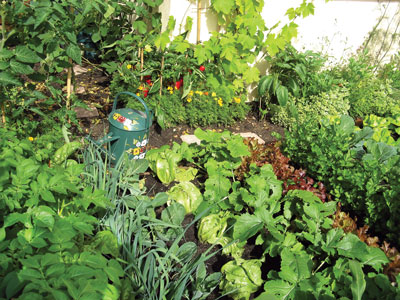
Using mulch on the ground around your vegetables protects the soil
PERENNIALS
Mulch: Mulch all bare ground with about three inches of organic mulch. Not only does mulch protect soil from pounding winter rains and suppress seed growth, it adds organic matter and nutrients to your soil as it decomposes. Use mulch made from either straw or wood chips.
Soil amendment: Add compost to the soil around your perennial plants. Sprinkle an inch or so of compost around the perennial (not against the stem), concentrating on the drip line. Gently work compost into the top few inches of soil, and then mulch over the top. Nutrients in the compost will fortify your plants, making them ready for vigorous and healthy spring growth.
Pruning: Prune plants to maintain desired size and shape and to increase sunlight exposure and air circulation. Read up on the growing habits of each species before pruning. For most herbaceous perennials, cut away dieback, and then prune by cutting above expressing nodes (places on the branch where you see sprouts of new growth). Always cut at an angle so rainwater will not collect on the fresh cut.
ANNUALS
Vegetables: In San Francisco, we are fortunate to be able to grow vegetables year round. If you choose to grow some produce this winter, try carrots, beets, lettuce, cabbage, bunching onions, broccoli, spinach, chard, kale, collards, and radishes. To protect the soil, mulch the bare ground around your plants with straw. (Do not work the straw into the soil.)
Cover crops: Try cover cropping in unused areas of your garden. Winter cover crops help to replenish soil nutrients, protect the soil from rain, improve soil tilth, and keep nutrients available for the next crop. Legumes actually fix nitrogen in the soil, increasing fertility.
Good winter cover crops in San Francisco are oats, vetch, fava or bell beans, and crimson clover (all but oats are legumes). Plant the cover crop densely in your annual beds. (With legumes, mix with innoculum before seeding. Innoculum contains nitrogen-fixing bacteria, which help legumes fix nitrogen from the air onto the plant roots. Innoculum in not essential, but will increase nitrogen fixing and therefore soil fertility.)
For maximum nitrogen fixing, cut the legume cover crop at ground level just before it flowers in the spring. (You may choose to let some of the crimson clover bloom because it is beautiful and attracts beneficial insects.) Leave roots in the soil, and work cut portion into the soil as a green manure, or remove and compost, then prepare the bed as you usually would for spring planting.
Julia Strzesieski is the marketing coordinator at Cole Hardware and can be reached at julia@northsidesf.com.








